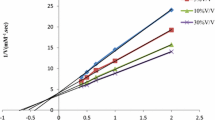Abstract
The insolubility of nitrile substrates in aqueous reaction mixture decreases the enzymatic reaction rate. We studied the interaction of fourteen water miscible organic solvents with immobilized nitrile hydrolyzing biocatalyst. Correlation of nitrilase function with physico–chemical properties of the solvents has allowed us to predict the enzyme behavior in such non-conventional media. Addition of organic solvent up to a critical concentration leads to an enhancement in reaction rate, however, any further increase beyond the critical concentration in the latter leads to the decrease in catalytic efficiency of the enzyme, probably due to protein denaturation. The solvent dielectric constant (ε) showed a linear correlation with the critical concentration of the solvent used and the extent of nitrile hydrolysis. Unlike alcohols, the reaction rate in case of aprotic solvents could be linearly correlated to solvent log P. Further, kinetic analysis confirmed that the affinity of the enzyme for its substrate (K m) was highly dependent upon the aprotic solvent used. Finally, the prospect of solvent engineering also permitted the control of enzyme enantioselectivity by regulating enantiomer traffic at the active site.










Similar content being viewed by others
References
Banerjee A, Kaul P, Banerjee U (2006) Purification and characterization of an enantioselective arylacetonitrilase from Pseudomonas putida. Arch Microbiol 184:407–418
Banerjee A, Sharma R, Banerjee U (2002) Nitrile degrading enzymes: current status and future prospects. Appl Microbiol Biotechnol 60:33–44
Kobayashi M, Shimizu S (2000) Nitrile hydrolases. Curr Opin Chem Biol 4:95–102
Kaul P, Banerjee A, Mayilraj S, Banerjee U (2004) Screening for enantioselective nitrilases: kinetic resolution of racemic mandelonitrile to (R)-mandelic acid by new bacterial isolates. Tet Assy 15:207–211
Banerjee A, Kaul P, Banerjee UC (2006) Enhancing the catalytic potential of nitrilase from Pseudomonas putida for enantioselective nitrile hydrolysis. Appl Microbiol.Biotechnol 72:77–87
Kaul P, Banerjee A, Banerjee U (2006) Enantioselective nitrile hydrolysis by immobilized whole-cell biocatalyst. Biomacromolecules 7:1536–1541
Layh N, Willetts A (1988) Enzymatic nitrile hydrolysis in low water systems. Biotechnol Lett 20:329–331
Klibanov A (2001) Improving enzymes by using them in organic solvents. Nature 409:241–246
Yamamoto K, Oishi K, Fujimatsu I, Komatsu K (1991) Production of R-(-)-mandelic acid from mandelonitrile by Alcaligenes faecalis ATCC 8750. Appl Environ Microbiol 10:3028–3032
Yamamoto K, Fujimatsu I, Komatsu KI (1992) Purification and characterization of the nitrilase from Alcaligenes faecalis ATCC 8750 responsible for enantioselective hydrolysis of mandelonitrile. J Ferment Bioeng 73:425–430
Liese A (2006) Industrial biotransformations, 2nd edn. Wiley-VCH, Weinheim
Kaul P, Stolz A, Banerjee UC (2007) Cross-linked amorphous nitrilase aggregates for enantioselective nitrile hydrolysis. Adv Synth Catal 349:2167–2176
Terreni M, Pegani G, Ubiali D, Fernandez R, Mateo C, Guisan JM (2001) Modulation of penicillin acylase properties via immobilization techniques: one-pot chemoenzymatic synthesis of cephamandole from cephalosporin C. Bioorg Med Chem Lett 11:2429–2432
Furlenmeier A, Quitt P, Vogler K, Lanz P (1976) 6-Acyl derivatives of aminopenicillanic acid US Patent. Hoffmann-La Roche Inc., Nutley
Kinbara K, Sakai K, Hashimoto Y, Nohira H, Saigo K (1996) Design of resolving reagents: p-substituted mandelic acids as resolving reagents for 1-arylalkylamines. Tet Assy 7:1539–1542
Surivet JP, Vatele JM (1999) Total synthesis of antitumor goniothalamus styryllactones. Tetrahedron 55:13011–1328
Mills J, Schmiegel KK, Shaw WN (1983) Phenethanolamines, compositions containing the same and method for effecting weight control. Eli Lilly and Company, Greenfield
Reichardt C (1988) Solvent and solvent effects in organic chemistry. VCH, New York
Rekker R (1977) The hydrophobic fragmental constant. Elsevier, New York
Perutz M (1978) Electrostatics effects on protein. Science 201:1187–1191
Affleck R, Haynes C, Clark D (1992) Solvent dielectric effects on protein dynamics. Proc Natl Acad Sci USA 89:5167–5170
Fitzpatrick P, Klibanov A (1991) How can the solvent affect enzyme enantioselectivity. J Am Chem Soc 113:3166–3171
Wescott C, Klibanov A (1993) Solvent variation inverts substrate specificity of an enzyme. J Am Chem Soc 115:1629–1631
Zaks A, Klibanov A (1986) Substrate specificity of enzymes in organic solvents vs. water is reversed. J Am Chem Soc 108:2767–2768
Wescott C, Klibanov A (1997) Thermodynamic analysis of solvent effect on substrate specificity of lyophilized enzymes suspended in organic media. Biotechnol Bioeng 56:7294–7299
Tawaki S, Klibanov A (1992) Inversion of enzyme enantioselectivity mediated by the solvent. J Am Chem Soc 114:1882–1884
Acknowledgments
Praveen Kaul gratefully acknowledges financial assistance provided by Council of Scientific and Industrial Research, India. This is NIPER communication No. 379.
Author information
Authors and Affiliations
Corresponding author
Rights and permissions
About this article
Cite this article
Kaul, P., Banerjee, U.C. Predicting enzyme behavior in nonconventional media: correlating nitrilase function with solvent properties. J Ind Microbiol Biotechnol 35, 713–720 (2008). https://doi.org/10.1007/s10295-008-0332-y
Received:
Revised:
Accepted:
Published:
Issue Date:
DOI: https://doi.org/10.1007/s10295-008-0332-y




